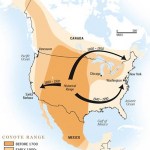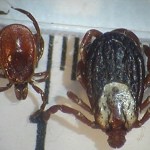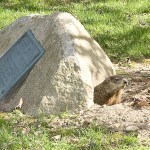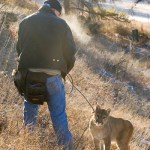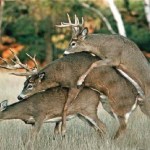For those of you in the general vicinity, the University of Iowa Department of Epidemiology will be once again sponsoring the Great Plains Emerging Infectious Diseases Conference on April 19-20 in Iowa City. This year's keynote speaker will be Dr. Peter Daszak, President of the EcoHealth Alliance:
Dr. Peter Daszak, president of EcoHealth Alliance, is a leader in the field of conservation medicine and a respected disease ecologist. EcoHealth Alliance is a global organization dedicated to innovative conservation science linking ecology and the health of humans and wildlife. EcoHealth Alliance's…
wildlife
This is the twelfth of 16 student posts, guest-authored by Stanley Corbin.
Disease in wildlife is an important concern to the health and safety of humans and domestic animals. The expanding growth of our nation and resultant land use changes with urbanization has resulted in a shrinking habitat and fragmentation for all animals, including humans. The effects of ecological disruption are universally recognized and adversely effects wildlife through multiple mechanisms.
Hand it to the coyote (Canis latrans) for its ability to exist with humans. The resilience of this animal can be…
Typically when we think of flying things and influenza viruses, the first images that come to mind are wild waterfowl. Waterbirds are reservoirs for an enormous diversity of influenza viruses, and are the ultimate origin of all known flu viruses. In birds, the virus replicates in the intestinal tract, and can be spread to other animals (including humans) via fecal material.
However, a new paper expands a chapter on another family of flying animals within the influenza story: bats.
I've written previously about the enormous diversity of microbes that bats possess. This shouldn't be…
This guest post was written by Brookhaven Lab science writing intern Kenrick Vezina, who will be sharing Brookhaven science stories from inside and outside laboratories on site through mid December.
I'm about to enter the well-worn, vegetation-free (read: tick-free) pathway that cuts through the forest near my dorm. I'm about two steps down the trail when I hear a screech from somewhere in the canopy overhead. It's not the full-out war cry of a red-tailed hawk -- the sound we've been trained by television to expect from the beak of every bird of prey -- but it definitely sounds like a raptor…
This guest post was written by Brookhaven Lab science writing intern Kenrick Vezina, who joined our team this month and will be sharing Brookhaven science stories from inside and outside laboratories on site through mid December.
On Saturday, September 10, I rode into Brookhaven National Laboratory for the first time. Within two hours, I was watching a handful of white-tailed deer on a strip of grass near the Princeton Avenue gate.
I'm a new intern in the Lab's Media & Communications Office, fresh from MIT's Graduate Program in Science Writing, here to report on all of the fascinating…
tags: How Poachers became Caretakers, Namibia, conservation biology, endangered species, wildlife, poachers, John Kasaona, TEDTalks, TED Talks, streaming video
In his home of Namibia, John Kasaona is working on an innovative way to protect endangered animal species: giving nearby villagers (including former poachers) responsibility for caring for the animals. And it's working.
TEDTalks is a daily video podcast of the best talks and performances from the TED Conference, where the world's leading thinkers and doers give the talk of their lives in 18 minutes. Featured speakers have included Al…
Audubon's Ted Williams explains that staged images have taken over the animal photography business and argues that these ubiquitous phonies give the public an inaccurate view of nature:
Audubon has sent me to lots of wild places over the past 31 years, but I'd seen only one wolf and three cougars (a litter) until December 8, 2009. On that day, before noon in the Glacier National Park ecosystem of northwestern Montana, I encountered not just one wolf but two and not just one cougar but two! What were the chances of that?
Well, they were 100 percent, because I'd rented the animals for a photo…
Image via Discovery Press Web.
In his monumental 1945 monograph on mammal classification, paleontologist G.G. Simpson appraised the living species of elephants to be "relicts of a dying group." The living African (Loxodonta) and Asian (Elephas) elephants were all that remained of the past diversity of proboscideans, and human activities put even these large mammals at risk of extinction. Poaching and human development on land bordering game preserves continue to put elephants at risk, and the two-hour BBC special The Secret Life of Elephants, airing this Sunday on Animal Planet in the US,…
Mt. Saint Helens erupting in 2004.
I had a chance to watch a new NOVA special that airs May 5 (PBS) on the 1980-1986 and 2004-2008 eruption cycles at Mt. Saint Helens, along with the recovery of the blast zone from the 1980 eruption. It is a fitting episode as we approach the 30th anniversary of the eruption that took out the north side of the volcano and devastated a vast swath of Cascade wilderness in Washington on May 18, 1980. Many of you have already sent me your Mt. Saint Helens memories (keep them coming!) for my tribute to the eruption, but if you want to get started on remembering…
There's an old parable about blind men and an elephant; each touches a different part of the great beast and comes to a wildly different conclusion about what stands before them. This parable shares some similarities with science, since we're all probing the secrets if the universe in different places and ways. Unlike the ancient blind men, however, we have the advantage of things like blogs to compare notes between what we find. Take the elephant itself: today's links examine pachyderms from three different perspectives. At The Thoughtful Animal, Jason Goldman looks at elephantine…
A family of North American river otters (Lontra canadensis), photographed in Yellowstone National Park.
Ever since the giant squid's star-turn in 20,000 Leagues Under the Sea, cephalopods have shown promise in the world of film. Though sharks may get the glory (and the title roles), their tentacled nemeses stole a scene in Oldboy and were conspicuous by their absence in Watchmen. Now they're stealing more than scenes: watch as one clever octopus makes off with an entire video camera in this recent underwater video. In a second video, the featured octopus isn't as lucky when it tries to steal a wrench. And if real-life cephalopods aren't your thing, check out the robotic squid in the short film…
A margay (Leopardus wiedii). From Wikipedia.
Even if they spend years in the field, researchers rarely witness predation on primates. Cats, birds, and other hunters regularly feed on primate species, but what we know about the habits of primate-hunters often comes from bones and fingernails picked out of predator droppings. Every now and again, though, someone is in just the right place at just the right time to observe a predator attempt to catch a primate for dinner, and one recent observation in the Amazon has revealed an ingenious hunting technique employed by a small spotted cat.…
tags: Sanderlings Schiermonnikoog, birds, birding, wildlife, humans, conservation, education, streaming video
This is a sweet little video about the Sanderlings that nested on the Niederlande beach of Schiermonnikoog. However, in just a few short years, they are rarely seen there. Why? This video provides some hypotheses.
There is a brief mention of a book (in Dutch) at the end. I've never seen it, don't own it and have absolutely no vested interest in it or anything involved with it.
tags: bear sighting, wildlife, news reporting, slow news day, WJW Fox 8 Cleveland, television, humor, funny, fucking hilarious, streaming video
OMG, THERE'S A BEAR IN MY BACKYARD!!!11!!eleventy!!! This video is an amusing look at what happens when a news reporter and his camera crew clearly have too much time (and technology) on their hands ...
News!
Toba caldera in Indonesia.
We're all still talking about the Chilean earthquake and the coverage of the event. If you happen to live in the Columbus area, you might have heard me on WTVN talking about the earthquake as well.
The Toba (Indonesia) eruption 74,000 years ago has been used by some researchers to be the cause of a "genetic bottleneck" for humans - however, that is still much debated. Currently, excavations are under away near Toba to look for evidence of human habitation that was buried by the eruption. The evidence of stone tools that appear to be made by the same human…
Catching up with some news:
Anatahan erupting in the northern Mariana Islands in 2003.
I ran across this article right before I got sick, but its been popping up around the interwebs (and is pretty interesting). It details a study in Molecular Ecology that suggests that populations of caribou in Canada's Yukon Territory were strongly effected by the White River Tephra. The White River Tephra is supposedly the largest Holocene plinian tephra (from a ash cloud fallout), with two components dating from ~1900 years ago and ~1250 years ago. The vent for the WRT is likely from a vent beneath the…
It didn't take long in the new year to get started!
Nymuragira erupting in January 2010.
Nyamuragira in the Congo erupted to start off the new year, producing explosions and lava flows. The flow are moving down the southern flank of the volcano. The eruption started with loud, concussive noises at 3:45 AM that startled rangers at the National Park that surround the volcanoes Nyamuragira and Nyiragongo. It appears that there was some part of the eruption that was either fire fountains or strombolian as the rangers describe the early events as "fire with sparks flying". The lava flows from…
Last week, Dan Delong, an English teacher at Southwestern High School in Piasa, Illinois was suspended for allowing students to read an article on homosexuality in the animal kingdom. The article in question, "The Gay Animal Kingdom," was written by ScienceBlogger Jonah Lehrer of The Frontal Cortex, and published by Seed magazine in 2006. Mr. Delong faced a school board hearing on Monday and stood to lose his job over the incident. Jonah, along with many other ScienceBloggers, rallied support for Mr. Delong, as well as science education and literacy everywhere. Mike Dunford of the…
News to finish up your week:
Summit area of Hualalai in Hawai'i
Another day, another "threat" of volcanic eruption in Australia. I'm impressed with the abject fear Aussies seem to have for this perceived increased threat of an eruption - or at least what the press wants you to believe. This time, watch out near Bundaberg, Townsville and Cooktown in southeast Queensland!
In more press-related exaggeration, the Siberian Traps - a flood basalt eruption from, well, thousands of rift/vents in Siberia - is boiled down to being one Siberian volcano by the Telegraph. Dr. Mark Sephton of the…
